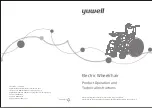
A.CHOOSE THE RIGHT CHAIR & SAFETY OPTIONS
Sunrise provides a choice of many power wheelchair styles, sizes
and adjustments to meet the needs of the user. However, final
selection of a wheelchair rests solely with you and your health care
professional. Choosing the best chair for you depends on such
things as:
1.Your size, disability, strength, balance and coordination.
2. Your intended use, and your level of activity.
3. The types of hazards you must overcome in daily use (in
areas where you are likely to use your chair).
4. The need for options for your safety and comfort (such as
positioning belts or special seating systems).
B. ADJUST CHAIR TO YOUR ABILITY
You need to work with your doctor, nurse or therapist, and
your supplier, to fit this chair and adjust the controller set-
tings for your level of function and ability.
C. REVIEW THIS MANUAL OFTEN
Before using this chair you, and each person who may assist you,
should read this entire Manual and make sure to follow all instruc-
tions. Review the warnings often, until they are second nature to
you.
D.WARNINGS
The word “WARNING” refers to a hazard or unsafe practice
that may cause severe injury or death to you or to other per-
sons. The “Warnings” are in four main sections, as follows:
1. V — EMI
Here you will learn about electromagnetic interference and
how it can affect your chair.
WARNING
Heed all warnings to reduce the risk of unintended
brake release or chair movement:
1. Beware of the danger from hand-held transceivers.
Never turn on or use a hand-held transceiver while
power to your chair is on. Use extra care if you believe
that such a device may be in use near your chair.
2. Be aware of nearby radio or TV stations, and avoid
coming close to them.
3. If unintended movement occurs, turn your chair off as
soon as it is safe to do so.
A.WHAT IS EMI?
WARNING
1. EMI means: electromagnetic (EM) interference (I). EMI
comes from radio wave sources such as radio transmitters
and transceivers. (A “transceiver” is a device that both sends
and receives radio wave signals).
2. VI — GENERAL WARNINGS
Here you will find a safety checklist and a summary of risks
you need to be aware of before you ride this chair.
3. VII — WARNINGS — COMPONENTS & OPTIONS
Here you will learn about your chair. Consult your supplier
and your health care professional to help you choose the
best set-up and options for your safety.
4. XI — BATTERIES
Here you will learn about battery and charger safety, and
how to avoid injury.
Q-NOTE-
Where they apply, you will also find “Warnings”
in othersections of this Manual.
Throughout this owner’s manual and on the wheelchair
you will see the icons listed below to identify warnings and
potential hazards. It is important to read and understand
all of them.
WARNING!
These warnings must be followed, failure to
do so may cause personal injury or may dam-
age the wheelchair.
PROHIBITED!
Prohibited actions must never be performed.
Performing an action that is prohibited can
cause personal injury or may damage the
wheelchair.
Q-NOTE:
Q-Notes are informative statements to help
further explain actions, warnings or product
detail.
ESD:
Electrostatic Discharge has a potential to
damage printed circuit boards unless handled
correctly. When the ESD symbol is shown
throughout the owner’s manual, use the
Proper Handling Techniques Insert supplied
with the chair to properly handle printed cir-
cuit boards.
2. There are a number of sources of intense EMI in your daily
environment. Some of these are obvious and easy to avoid.
Others are not, and you may not be able to avoid them.
3. Powered wheelchairs may be susceptible to electromagnetic
interference (EMI) emitted from sources such as radio stations,
TV stations, amateur radio (HAM) transmitters, two
way radios, and cellular phones.
4. EMI can also be produced by conducted sources or electro-
static discharge (ESD).
V. EMI (ELECTROMAGNETIC INTERFERENCE)
IV. NOTICE –READ BEFORE USE
Quickie
Xplore
Owner’s
Manual
Rev.
B
5.






































